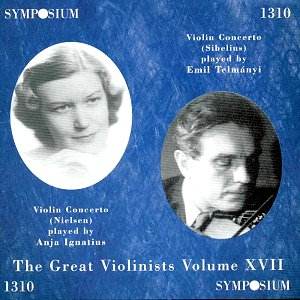AVAILABILITY
www.symposiumrecords.co.uk
This
coupling seems so perfectly logical that one wonders why no-one
has thought of it before. One reason maybe is the relative scarcity
of the Ignatius Sibelius and its obscurity in the face of the
legion of recordings that gained more international currency.
From Heifetz onwards generations have looked to such as he and
Oistrakh, Neveu, Francescatti, Stern, Haendel and Perlman, not
to mention numerous contemporary recordings that have so swollen
the catalogue. More out of the way items, such as this wartime
commercial recording or the contemporaneous off-air Kulenkampff-Furtwängler
constitute more specialist fare. But as with Symposium’s Příhoda
disc, in which they resurrected his wartime Berlin recording of
the Dvořák Concerto, so they do it again with this performance.
The two performances stand in compelling parallel; native musicians
fully conversant with the repertoire, indeed committed exponents
of it (Ignatius toured the Sibelius in America with Koussevitzky
amongst others) whose authority seems only to deepen on retrospective
analysis. This is equally, indeed marvellously true, in the case
of the Telmanyi Nielsen. The violinist became Nielsen’s son-in-law
in 1918, by which time he had already premiered Dohnányi’s
Violin Concerto (presumably No. 1) and become one of the earliest
exponents of the Elgar. After the first soloist, Peder Møller,
Telmanyi became the Nielsen’s most faithful exponent, introducing
it to Berlin, Vienna, Berlin and London and performing it with
Nielsen conducting on at least five occasions. As with Ignatius
he was a noted Sibelian, recording the Concerto for Tono with
Jensen conducting.
Ignatius’s
Sibelius is unusually intimate. She doesn’t make a big sound,
doesn’t dig frantically into the strings or indulge in luscious
finger position changes. Her opening paragraphs are cool with
one notably cool slide (though she’s a fairly clean player when
it comes to portamenti). There is nothing here of the barbed wire
intensity of Heifetz or the muscularity of Stern or even Ginette
Neveu’s concentratedly profound drama. What Ignatius develops
instead is a compelling sense of narrative. She shapes and unfurls,
muses and drives with a sure sense of weight and structural acuity;
these are long-term architectural ambitions and can leave colourists
and exploiters of incidental felicity seeming lesser musicians
in the light of her surer understanding. How well Järnefelt
supports her, as well, underscoring those recurrent running orchestral
pizzicati and providing her with the elasticity of tempo to inflect.
She sways with the first movement double stops, has a strong affinity
with Sibelian rubati, and is introspective and frequently musing
in tone. The orchestral tuttis aren’t as hammered and forceful
as they often can be (there is a little blasting and wear on the
copies) and that is consonant with their interpretation as a whole.
She isn’t out to impress in the cadenza; doesn’t engage in colouristic
effect but instead demonstrates the value of subtly holding back
the rhetoric thereby implying far more.
The
slow movement emerges in Ignatius’ hands – compellingly I have
to say – not as an entity in and of itself but rather as a kind
of consoling culmination of the earlier movement’s constantly
elastic volatility. Her passion is followed by an almost expressionist
brooding, winds following the solo line’s ascent with something
approaching solemn catharsis. There is something wounded at the
core of this music-making – easy, though not necessarily true,
to attribute this to the circumstances of the recording – but
it’s conveyed at a flexibly flowing tempo. The finale is all elegance
and drive but it encompasses far more than these two. It moves
with surety and direction to a darkened vista; her harmonics are
excellent, the conclusion strong, determined, not grim but not
overwhelmingly triumphant either. It is a performance that forces
one to reassess the work, even in the light of so many performances
heard and admired.
The
Nielsen is a post-war Tono and sounds resonant and clear. It’s
not a particularly rare set, unlike the Sibelius, which is, and
consequently we can listen with few distractions, even though
there’s the usual ration of Tono surface noise (owners of British
Deccas of this period will know what to expect though the Nielsen
has been sympathetically edited and re-mastered). Telmanyi was
a famous exponent of Bach and it’s not I think fanciful to suppose
his affinities were stimulated by the classicist ethos that runs
through the Nielsen. He’s more of a romantic than Ignatius – he
was a Hungarian by birth – and his Hubay training equipped him
with greater weight of colouration but also an occasionally troublesome
vibrato characteristic of that school. I have to say it’s not
in evidence here. He brings a limpid tone to the Praeludium, has
a wonderfully fast trill, phrases lyrically and magically and
is marvellously effective throughout. The Italian Egisto Tango
brings buoyant energy to the Allegro Cavalleresco and the soloist
is warm and openhearted in his response, lyrical and effusive;
he drives out of the cadenza with real elegance. In the Poco Adagio
he is expressive without recourse to any smeariness or italicisation
and I thrilled to the Rondo finale, which becomes one big chamber
music exchange in these masterful hands. There is real tonal confluence
between solo violin and wind principals and choirs; exchanges
are apt and musicianly, the witty and humorous pointing before
the slashing sureties of the final bars giving us even more to
admire.
My
enthusiasm for these two performances is exceeded only by my admiration
for them. As with the Dvořák I recommend them not as examples
of past performance practice or historical documents, or as fine
performances to be suffered because of their relatively early
sonics – I recommend them as still vital and living embodiments
of tradition, as selfless and sympathetic interpretations, and
as necessary acquisitions for those whose interest in these two
works lies beyond the merely contemporary.
Jonathan
Woolf

![]() Emil Telmanyi (violin)
Emil Telmanyi (violin)![]() SYMPOSIUM 1310 [67.22]
SYMPOSIUM 1310 [67.22]